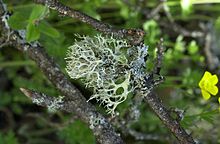Oakmoss
| Oakmoss | |
|---|---|

| |
| Scientific classification | |
| Domain: | Eukaryota |
| Kingdom: | Fungi |
| Division: | Ascomycota |
| Class: | Lecanoromycetes |
| Order: | Lecanorales |
| Family: | Parmeliaceae |
| Genus: | Evernia |
| Species: | E. prunastri
|
| Binomial name | |
| Evernia prunastri (
Ach. (1810) | |
| Synonyms | |
| |
Oakmoss (scientific name Evernia prunastri) is a
perfumery
.
Commercial uses
Oakmoss is commercially harvested in countries of South-Central Europe and usually exported to the
absolutes and extracts. These raw materials are often used as perfume fixatives and form the base notes of many fragrances.[1] They are also key components of Fougère and Chypre class perfumes. The lichen has a distinct and complex odor and can be described as woody, sharp and slightly sweet. Oakmoss growing on pines have a pronounced turpentine
odor that is valued in certain perfume compositions.
In parts of Central
rural, and industrial sites. Studies of bioaccumulation for zinc, lead, chromium, cadmium, and copper in lichen samples were performed five times at regular intervals between November 2000 and December 2001. As expected, the rural areas showed smaller impact of those five heavy metals when compared to urban and industrial areas.[2]
Health and safety information
Oakmoss should be avoided by people with known skin sensitization issues.[3] Its use in perfumes is now highly restricted by International Fragrance Association regulations, and many scents have been reformulated in recent years with other chemicals substituted for oakmoss.[4]
Conservation status
Evernia prunastri is listed as
IUCN
.
Gallery
Wikimedia Commons has media related to Evernia prunastri.
-
Close-up photo showing branches with soredia
See also
- Ethnolichenology
- Pseudevernia furfuracea, used as a substitute for oakmoss in perfumery
References
- ^ "Atlas of Perfumed Botany". MIT Press. Retrieved 2022-12-20.
- S2CID 97934357.
- ^ Survey and health assessment of chemical substances in massage oils
- ^ "IFRA standards library: oakmoss". Archived from the original on 2018-12-20. Retrieved 2014-09-19.
- ^ Náttúrufræðistofnun Íslands [Icelandic Institute of Natural History] (1996). Válisti 1: Plöntur. (in Icelandic) Reykjavík: Náttúrufræðistofnun Íslands.

